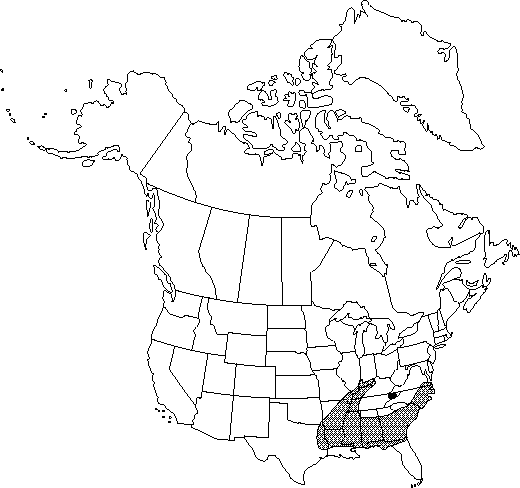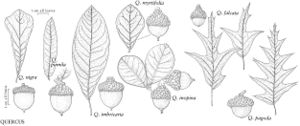Difference between revisions of "Quercus pagoda"
Alsogr. Amer., 23. 1838.
FNA>Volume Importer |
FNA>Volume Importer |
||
| Line 17: | Line 17: | ||
|basionyms= | |basionyms= | ||
|synonyms={{Treatment/ID/Synonym | |synonyms={{Treatment/ID/Synonym | ||
| − | |name= | + | |name=Quercus falcata var. leucophylla |
|authority=(Ashe) E. J. Palmer & Steyermark | |authority=(Ashe) E. J. Palmer & Steyermark | ||
| − | }}{{Treatment/ID/Synonym | + | }} {{Treatment/ID/Synonym |
| − | |name= | + | |name=Quercus falcata var. pagodifolia |
|authority=Elliott | |authority=Elliott | ||
| − | }}{{Treatment/ID/Synonym | + | }} {{Treatment/ID/Synonym |
| − | |name= | + | |name=Quercus leucophylla |
|authority=(Elliott) Ashe | |authority=(Elliott) Ashe | ||
| − | }}{{Treatment/ID/Synonym | + | }} {{Treatment/ID/Synonym |
| − | |name= | + | |name=Quercus pagodifolia |
|authority=unknown | |authority=unknown | ||
}} | }} | ||
| Line 43: | Line 43: | ||
|elevation=0-300 m | |elevation=0-300 m | ||
|distribution=Ala.;Ark.;Fla.;Ga.;Ill.;Ind.;Ky.;La.;Miss.;Mo.;N.C.;Okla.;S.C.;Tenn.;Tex.;Va. | |distribution=Ala.;Ark.;Fla.;Ga.;Ill.;Ind.;Ky.;La.;Miss.;Mo.;N.C.;Okla.;S.C.;Tenn.;Tex.;Va. | ||
| − | |discussion=<p>Quercus pagoda is often treated as a variety of Q. falcata; it is quite distinctive, however, both morphologically and ecologically (S. A. Ware 1967; R. J. Jensen 1989).</p><!-- | + | |discussion=<p><i>Quercus pagoda</i> is often treated as a variety of <i>Q. falcata</i>; it is quite distinctive, however, both morphologically and ecologically (S. A. Ware 1967; R. J. Jensen 1989).</p><!-- |
| − | --><p>This species reportedly hybridizes with Q. falcata and Q. phellos (D. M. Hunt 1989).</p> | + | --><p>This species reportedly hybridizes with <i>Q. falcata</i> and <i>Q. phellos</i> (D. M. Hunt 1989).</p> |
|tables= | |tables= | ||
|references= | |references= | ||
| Line 57: | Line 57: | ||
|rank=species | |rank=species | ||
|parent rank=section | |parent rank=section | ||
| − | |synonyms= | + | |synonyms=Quercus falcata var. leucophylla;Quercus falcata var. pagodifolia;Quercus leucophylla;Quercus pagodifolia |
|basionyms= | |basionyms= | ||
|family=Fagaceae | |family=Fagaceae | ||
| Line 68: | Line 68: | ||
|publication year=1838 | |publication year=1838 | ||
|special status=Endemic;Selected by author to be illustrated | |special status=Endemic;Selected by author to be illustrated | ||
| − | |source xml=https://jpend@bitbucket.org/aafc-mbb/fna-data-curation.git/src/ | + | |source xml=https://jpend@bitbucket.org/aafc-mbb/fna-data-curation.git/src/8f726806613d60c220dc4493de13607dd3150896/coarse_grained_fna_xml/V3/V3_35.xml |
|genus=Quercus | |genus=Quercus | ||
|section=Quercus sect. Lobatae | |section=Quercus sect. Lobatae | ||
Revision as of 17:16, 18 September 2019
Trees, deciduous, to 40 m. Bark nearly black with narrow and noticeably flaky ridges, often resembling that of wild black cherry, inner bark orange. Twigs yellowish brown, 2-3.5 mm diam., pubescent. Terminal buds light reddish brown, ovoid, 4-9 mm, strongly 5-angled in cross section, puberulent throughout. Leaves: petiole 20-50 mm, glabrate or pubescent. Leaf blade ovate to elliptic or obovate, 90-300 × 60-160 mm, base cuneate to rounded or truncate, margins with 5-11 lobes and 10-25 awns, lobes oblong, rarely falcate, terminal lobe rarely exceeding lateral lobes in length, apex acute; surfaces abaxially pale, tomentose, adaxially glossy, glabrous, secondary veins raised on both surfaces. Acorns biennial; cup saucer-shaped to cup-shaped, 3-7 mm high × 10-18 mm wide, covering 1/3-1/2 nut, outer surface puberulent, inner surface pubescent, scale tips tightly appressed, acute; nut subglobose, 9-15 × 8-16 mm, often striate, puberulent, scar diam. 5-9 mm.
Phenology: Flowering spring.
Habitat: Poorly drained bottoms and mesic slopes
Elevation: 0-300 m
Distribution

Ala., Ark., Fla., Ga., Ill., Ind., Ky., La., Miss., Mo., N.C., Okla., S.C., Tenn., Tex., Va.
Discussion
Quercus pagoda is often treated as a variety of Q. falcata; it is quite distinctive, however, both morphologically and ecologically (S. A. Ware 1967; R. J. Jensen 1989).
This species reportedly hybridizes with Q. falcata and Q. phellos (D. M. Hunt 1989).
Selected References
None.
